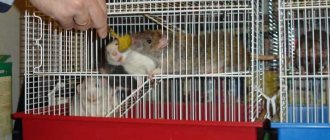Review author: “ZooVita”
Until recently, it was possible to get to know charming hedgehogs better only in the forest (if you were lucky) or in the zoo. But today, lovers of exotic animals are increasingly keeping cute animals at home. They look funny, don't tear up furniture or chew slippers, and don't cause allergies. But, on the other hand, even if they have warm feelings for their owners, they do not show them in any way.
Features of keeping a hedgehog at home
Keeping a hedgehog at home is not difficult. They are not picky eaters, do not shed, covering carpets and furniture with wool, and do not need to be combed or taken for walks. They are perfect for people with allergies and night owls who are accustomed to being nocturnal when all normal animals sleep.
A hedgehog, as a pet, is distinguished by a fairly high intelligence; it can respond to its nickname and adopt the habits of other four-legged inhabitants of the apartment.
Disadvantages of keeping hedgehogs at home
The hedgehog will not rush to greet its owners or purr before going to bed. These solitary animals are not very willing to get along with other pets, and small rodents may be considered legitimate prey.
A hedgehog cannot be stroked on its silky fur, and in a particularly angry mood, it can even prick its owners, especially babies.
They do not like loud sounds, noisy gatherings, or excessive attention to their person. If sovereignty is violated, the animal may bite.
You will have to have a separate house for the hedgehog, and the room should be quite spacious and secluded so that the pet does not feel restricted in its freedom and can hide if desired. Free walking around the apartment is not recommended: the animal may get hurt or cause damage to surrounding property.
A hedgehog is a nocturnal predator, so it will be quite difficult to sleep with it in the same room: the hedgehog will actively move, stomp, snort, sniffle and grunt.
You should not take a wild animal either, it will be very uncomfortable at home, and the owners will have a hard time.
A not-so-pleasant smell will accompany a hedgehog's stay, and tobacco smoke will become a nuisance for the animal.
Reproduction
The breeding season for hedgehogs begins immediately after emerging from hibernation. The animals become active, the males start fights for the females, and the hedgehogs themselves build nests.
Females become very caring mothers. They carry 2-8 cubs for 5-8 weeks. Hedgehogs are born blind, with soft pseudo-needles, up to 10 cm in size and weighing up to 20 grams. After two weeks, the weight reaches 60 grams, and the needles harden. The offspring are ready for independent life two months after birth.
A peculiarity of hedgehog reproduction is the duration of the mating season. The disadvantage of this is the death of autumn babies who did not have time to gain the weight of 800 grams necessary for hibernation.
Types of domestic hedgehogs
Currently, several breeds of domestic spiny animals have been bred.
African hedgehogs are becoming the most popular pets at home. Dwarf hedgehogs are small in size and have soft fur on their bellies. They move much more quietly than their forest relatives and can stay awake during the day, sleeping at night.
Steppe hedgehogs need to create a high temperature, but they do not like high humidity, and European animals tolerate the Russian climate well.
Ordinary hedgehogs, picked up in the forest or at the dacha, can also become apartment dwellers, but along with them, lichen, parasites and even rabies can enter the house, so it is better not to risk the health of your household and purchase a prickly pet from specialist breeders.
Breeding
Breeding African pygmy hedgehogs is a very important step. Initially, carefully weigh the pros and cons. You should have enough free time to care for your pregnant hedgehog and babies.
How to determine gender
To determine the sex, hold the hedgehog in your arms so that its belly is visible. In females, the genitals are located next to the anus. In males, they are located at a distance of approximately 1 cm from the anus in babies and 2–2.5 cm in adults.
Mating
For mating to be successful, the hedgehogs must be in the same age category
Hedgehogs become sexually mature at 5.5–6 weeks. Animals should not have inbreeding until at least the 3rd generation, so babies must be separated by gender in advance. Weak and sick hedgehogs cannot be bred.
A young male cannot be mated with an adult female. Due to inexperience, he can cause aggression and be bitten as a result. Mating can be done at 5.5–6 weeks, not earlier.
A female can become pregnant before 5.5 weeks. This cannot be allowed. She may not bear offspring or refuse to feed the cubs. A female should not be allowed to mate for more than 11 weeks if she has never given birth. Fused pelvic bones can complicate childbirth and lead to the death of a hedgehog.
Mating takes 6–7 days. There is no point in keeping animals together any longer. If mating does not occur, place the hedgehogs for a week, and then connect them again.
Males can be bred every 2 weeks. Female - no more than 2 times a year. Otherwise, she will kill her hedgehogs.
Pregnancy
Pregnancy in hedgehogs lasts 34–36 days. In a couple of weeks, the female gains 10–50 g in weight. On the 25th day, it is already clear that the hedgehog is pregnant: she becomes rounder, and her behavior also changes. She begins to take care of herself, her gait slows down.
How to care for newborn hedgehogs
It is better to touch newborn hedgehogs only with a cloth.
In the first days of the babies' lives, the female behaves very nervously. She needs to be placed in a separate cage and ensure complete rest. Otherwise, she may refuse to feed the offspring or even kill them.
It is better not to touch small hedgehogs - the female may refuse them if she smells a person. But sometimes situations arise when holding a baby is simply necessary. In this case, wash your hands thoroughly with plain water, put on clean clothes and try to avoid any odors. When you pick up the baby, distract the female. The same must be done when you put it back.
For the first 2 weeks, hedgehogs eat only mother's milk, then she begins to bring them other food. By 2 months, hedgehogs are no longer completely dependent on their mother.
Nutrition for hedgehogs at home (diet)
The hedgehog is considered an unpretentious animal, and the question of “what to feed a pet hedgehog” is solved quite simply.
The pet will happily eat lean meat, offal, live insects, fish, cereals, bread, any dairy products and vegetables. The only mandatory component of a healthy diet is raw meat.
What can you feed a hedgehog?
If you feed a hedgehog in the garden for a while, after a while he will get used to it and may bring his entire hedgehog family to you. What does a hedgehog eat, besides insect pests and rodents?
Animal feed
Hedgehogs prefer food of animal origin to any other food.
- Raw meat (chicken, beef, lamb, veal, turkey, rabbit). You can also feed the hedgehog boiled meat, not salted, without seasonings or spices.
- Bloodworm.
- Liver, kidneys, heart, ventricles, raw or boiled.
- Raw or boiled egg.
- Cottage cheese is low-fat.
- Cheese.
- The fish is raw. In nature, hedgehogs cannot reach fish, and for this reason they do not eat them. You can try feeding him a small amount of raw fish. It will not bring any benefit to the hedgehog, but in small quantities it will not cause harm.
Fruits, vegetables, berries and herbs
Hedgehogs, wandering into a garden plot, love to feast on fallen tree fruits: apples, pears. They can also eat various berries that have fallen on the ground. Among greens, hedgehogs prefer dandelion leaves and carrot tops.
You can give your hedgehog raw carrots. It must be washed, cut into pieces, or grated.
Raw potatoes contain a large amount of starch and solanine, so it is not advisable to feed them to your hedgehog. You can give your hedgehog a small amount of boiled potatoes.
What else can you feed a hedgehog?
- Boiled pasta.
- Porridge cooked in water. Oatmeal, rice, buckwheat, millet, pearl barley.
- Nuts, seeds.
- Cookie.
- Bread.
- Fresh mushrooms.
- Cat and dog food (not recommended).
Water for the hedgehog.
Be sure to offer your hedgehog clean drinking water. In hot weather, the hedgehog often goes far in search of water. In the forest, water can be difficult to find and the animal may die from dehydration.
If you have fed a hedgehog on your property, or you have a family of hedgehogs living in your home, you should definitely put a bowl of water and add water every day. You need to choose a shallow bowl; it is advisable to secure it so that the hedgehogs do not turn it over.
When and how much to feed your hedgehog
Hedgehogs are active at night. Therefore, treats and treats need to be prepared and served in the evening.
For wild hedgehogs, unlike domestic ones, there are no restrictions on the amount of food. They are able to independently determine the norm. Don't leave too much food, it will start to spoil. The norm of food for a hedgehog can be determined experimentally by observing it for a couple of days.
The active period for hedgehogs lasts from April to October. Before hibernation, hedgehogs specifically gain weight to form a fat reserve. Therefore, during this period you need to increase the amount of food. If the hedgehog does not gain enough weight, it may wake up from hunger in the winter and die.
It is recommended to actively feed hedgehogs in the spring, when they emerge from hibernation. They have spent their fat reserves over the winter and will immediately go in search of food.
- milk and dairy products;
- sweet, salty, fried;
- cabbage;
- raw potatoes;
- sausage;
- pork (too fatty).
Features of caring for a hedgehog at home
For the hedgehog you will have to have a spacious enclosure. The most suitable parameters are considered to be a square with a side of 80-90 centimeters. The height of the structure should be twice the height of the pet standing on its hind legs.
You should not use a plastic container for your hedgehog to live in; when using a metal cage, pay special attention to the width between the bars. The animal should not crawl out or get stuck halfway to freedom.
Mesh floors are also not a good solution; tiny paws can get injured while running or get stuck in the mesh.
It is better to locate the dwelling in a secluded corner, where drafts and strong heat from radiators and radiators will not reach. They also hide it from active sunlight.
The ideal temperature is considered to be 22-26 degrees. Exceeding this threshold will cause the animal to overheat, lowering it will lead to hibernation.
Like people, a pet’s home should be divided into a shaded sitting area, a play area, a dining room and a toilet. To avoid a pungent odor, the bottom of the cage is covered with sawdust, which is changed periodically.
Inside the enclosure they install a running wheel, a house for sleeping, and lay out sticks, pine cones, and leaves.
How to walk a pet hedgehog (rules)
If there is a spacious enclosure, the hedgehog will have enough space for leisurely walks and games. In the summer, the cage with the animal can be taken out to the balcony, but the animal should not be left under the scorching rays of the sun or in a hot and stuffy room.
It is not worth walking with an animal on the street: the hedgehog is not suitable for such a pastime, and the abundance of unfamiliar noises will negatively affect its psyche.
Live, hedgehog, live!
About 5 years of life are measured by nature for spiny mammals in the wild, 8-10 years - this is how long domestic hedgehogs live with good and proper care.
To give your pet several years of life, you need to thoroughly study the features of its maintenance, diet and know some of the nuances that are simply necessary for the life of a prickly cutie.
In particular, hibernation is vital for the domestic hedgehog - without it it will die. To give your baby a winter nap, it is necessary first for the hedgehog to gain “fat” and gain about 50% of its weight.
Note!
- How to choose a mattress and not make a mistake? Review of the best models, size table
- Cotton blanket: advantages and disadvantages, rules of choice and care
- Review of ideas for exterior home decoration
To create favorable conditions for winter sleep, place the cage with the hedgehog in a cool place and cover it with dry grass or moss. Hibernation will last about 2 months; if the place is cold enough, the thorn will sleep until spring.
What is dangerous for a hedgehog in an apartment?
You should not let a curious animal roam around your apartment or house.
A thorny animal can get stuck somewhere in a tight space, from where it will be very difficult to remove it.
Hedgehogs like to gnaw wires, bite off plastic parts, and swallow anything on the floor, which is not good for your health.
It is difficult to train an animal to use the toilet, so it can relieve itself in any accessible corner, and the discharge has a very unpleasant aroma that will emanate from under the bed or closet for a long time.
During molting, a hedgehog loses about 20% of its needles, which will remind all other inhabitants of themselves for a long time.
Some tips on how to care for a hedgehog at home
Having decided to get a cute prickly friend, you need to prepare for him:
- the cage is a place of shelter, sleep, toilet and food;
- bowls;
- supply of hay and sawdust;
- feed.
How to care for a hedgehog at home? The main thing is to remember that a hedgehog is not a toy. He needs to be fed, bathed, walked, cleaned in his cage, and communicated with him regularly so that he recognizes his owner.
How to bathe a pet hedgehog (step-by-step instructions)
Very often you can see photos of a domestic hedgehog taking water treatments or resting after them. The animals are not afraid of water, but they don’t really like to swim, although they won’t protest much.
Wash pets with baby soap or shampoo, making sure that water does not get into the ears or face of the animal. The foam is washed off with water from your palms: the pressure from the shower or tap will be a strong shock for the hedgehog. The needles are cleaned with a soft toothbrush.
After finishing the washing procedures, the animal’s skin is lubricated with oil and the claws are trimmed.
Checking to see if you are overfeeding your hedgehog
An adult hedgehog should easily curl up into a ball if it is in danger. Often only the nose will stick out from such a ball, but sometimes the nose is also hidden. In this case, the hedgehog is healthy, its nutrition is normal. The color of a hedgehog can be very diverse. More and more species of different flowers are appearing in nurseries. In general, the color of the hedgehog is dark, the eyes are black. There may also be a light color and red eyes. Light colors have one significant disadvantage: albinos often experience skin irritation. The skin sometimes peels off, needles can fall out, and full bald spots form. In this case, you need to use natural oils.










